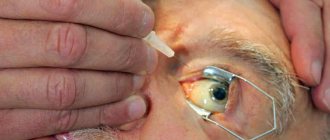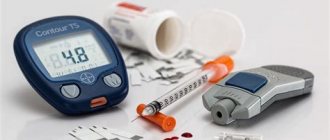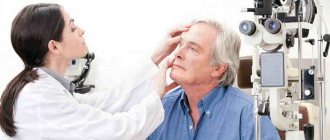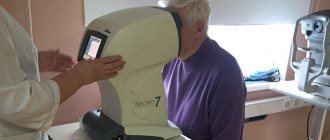Macular edema is swelling of the central area of the retina (macula, or macula), which is responsible for central vision. The macula is located opposite the pupil, slightly above the junction of the eye and the optic nerve. It received its second name - yellow spot - due to the content of yellow pigment in the cells. In the central part of the macula, the retina is very thin and contains a large number of photoreceptors - light-sensitive cone cells, which form central vision, the area of greatest visual acuity. Thanks to cones, a person sees well in daylight and can distinguish colors. Therefore, pathologies of the macula can significantly reduce vision.
Macular edema is not an independent disease, but a manifestation of certain eye diseases or conditions: diabetic retinopathy (damage to the retinal vessels in diabetes), eye injury or the consequences of surgery, uveitis (inflammation of the choroid), occlusion of the retinal veins. Retinal vein occlusion is one of the most dangerous eye pathologies, which can lead to irreversible vision loss. Unfortunately, in recent decades, experts have noted a trend towards an increase in the number of people who are diagnosed with retinal vein occlusion.
Retinal vein occlusion is a blockage of the veins and capillaries of the retina. Most often it occurs due to hypertension and atherosclerosis.
Factors contributing to the formation of macular edema:
- age over 40-50 years;
- diabetes;
- hyperlipidemia (abnormally elevated levels of lipids (fats), cholesterol in human blood);
- obesity;
- physical inactivity (decreased motor activity);
- increased intraocular pressure;
- concomitant inflammatory diseases;
- increased blood viscosity;
- acquired and congenital thrombophlebia.
The resulting thrombus disrupts the flow of blood through the vessel. There is no outflow of blood from the capillaries and veins. Blood enters the retina, causing it to thicken. Swelling occurs.
As a result of thrombosis, ischemia develops around the affected area - “oxygen starvation”, that is, a decrease in the concentration of hemoglobin in the blood. The body fights the lack of oxygen by growing new blood vessels. But all of them are formed with pathologically thin walls, through which the liquid part of the blood enters the retina. When the walls of abnormal blood vessels rupture, for example, with high blood pressure, blood enters the retina. The affected area is expanding. Due to swelling, the macula ceases to cope with its main task - to provide a person with good central vision. If macular edema is not removed in time, vision may be lost forever .
Side effect
From the endocrine system: decreased glucose tolerance, steroid diabetes mellitus or manifestation of latent diabetes mellitus, suppression of adrenal function, Itsenko-Cushing syndrome (including moon face, pituitary type obesity, hirsutism, increased blood pressure, dysmenorrhea, amenorrhea, myasthenia gravis , striae), delayed sexual development in children.
Metabolism: increased excretion of calcium ions, hypocalcemia, increased body weight, negative nitrogen balance (increased protein breakdown), increased sweating, hypernatremia, hypokalemia.
From the central nervous system: delirium, disorientation, euphoria, hallucinations, manic-depressive psychosis, depression, paranoia, increased intracranial pressure, nervousness or anxiety, insomnia, dizziness, vertigo, pseudotumor of the cerebellum, headache, convulsions.
From the cardiovascular system: arrhythmias, bradycardia (up to cardiac arrest); development (in predisposed patients) or increased severity of chronic heart failure, ECG changes characteristic of hypokalemia, increased blood pressure, hypercoagulation, thrombosis. In patients with acute and subacute myocardial infarction - the spread of necrosis, slowing down the formation of scar tissue, which can lead to rupture of the heart muscle; with intracranial administration - nosebleeds.
From the digestive system: nausea, vomiting, pancreatitis, steroid ulcer of the stomach and duodenum, erosive esophagitis, bleeding and perforation of the gastrointestinal tract, increased or decreased appetite, flatulence, hiccups; rarely – increased activity of liver transaminases and alkaline phosphatase.
From the senses: posterior subcapsular cataract, increased intraocular pressure with possible damage to the optic nerve, a tendency to develop secondary bacterial, fungal or viral eye infections, trophic changes in the cornea, exophthalmos.
From the musculoskeletal system: slower growth and ossification processes in children (premature closure of epiphyseal growth plates), osteoporosis (very rarely - pathological bone fractures, aseptic necrosis of the head of the humerus and femur), rupture of muscle tendons, steroid myopathy, decreased muscle mass (atrophy).
Dermatological reactions: delayed wound healing, petechiae, ecchymosis, skin thinning, hyper- or hypopigmentation, steroid acne, stretch marks, tendency to develop pyoderma and candidiasis.
Allergic reactions: generalized (including skin rash, skin itching, anaphylactic shock) and when applied topically.
Effects associated with immunosuppressive effects: development or exacerbation of infections (the appearance of this side effect is facilitated by jointly used immunosuppressants and vaccination).
Local reactions: with parenteral administration - tissue necrosis.
Diagnosis and treatment of macular edema
Severe macular edema can be detected by an ophthalmologist during a slit-lamp examination. Unfortunately, treatment at this stage does not always guarantee a favorable result; it requires a long time and great effort.
The disease in its early stages or a predisposition to its development can be detected by optical coherence tomography. Ophthalmologists at the Sakhalin Center for Eye Microsurgery recommend that people with factors that contribute to the formation of a blood clot in the veins and capillaries of the retina periodically undergo such an examination. Only in this way can macular edema be identified at an early stage and emergency measures taken to relieve it.
A coherence tomograph allows one to obtain two- and three-dimensional images of the structure of the retina and the structures of the optic nerve head, which makes it possible to identify pathologies at an early stage of development.
The most effective method of getting rid of most retinal pathologies (detachment, rupture, dystrophy) is laser coagulation. However, this treatment method is not applicable for macular edema, since laser exposure can damage the macula. To relieve macular edema, a conservative method is used , the essence of which is the use of various anti-inflammatory drugs (injections, tablets, drops). As a result of numerous studies, it has been found that drugs containing synthetic analogues of glucocorticosteroids (hormones produced in the adrenal cortex) are highly effective. To obtain maximum results, they are injected directly into the vitreous body - intravitreal. However, despite their greater effectiveness compared to other drugs (drops, tablets), the duration of the therapeutic effect in many cases remained short due to the fact that with the usual method of drug administration, the active substance is absorbed all at once. An innovative approach to the treatment of macular edema was implemented in the drug "Ozurdex".
special instructions
Caution should be used in case of parasitic and infectious diseases of a viral, fungal or bacterial nature (currently or recently suffered, including recent contact with a patient) - herpes simplex, herpes zoster (viremic phase), chickenpox, measles, amoebiasis, strongyloidiasis (established or suspected), systemic mycosis; active and latent tuberculosis. Use for severe infectious diseases is permissible only against the background of specific therapy.
It should be used with caution within 8 weeks before and 2 weeks after vaccination, with lymphadenitis after BCG vaccination, with immunodeficiency conditions (including AIDS or HIV infection).
Use with caution in diseases of the gastrointestinal tract: gastric and duodenal ulcers, esophagitis, gastritis, acute or latent peptic ulcers, recently created intestinal anastomosis, nonspecific ulcerative colitis with the threat of perforation or abscess formation, diverticulitis.
Should be used with caution for diseases of the cardiovascular system, incl. after a recent myocardial infarction (in patients with acute and subacute myocardial infarction, the necrosis focus may spread, the formation of scar tissue may slow down and, as a result, the heart muscle ruptures), with decompensated chronic heart failure, arterial hypertension, hyperlipidemia), with endocrine diseases - diabetes mellitus ( including impaired tolerance to carbohydrates), thyrotoxicosis, hypothyroidism, Itsenko-Cushing's disease, with severe chronic renal and/or liver failure, nephrourolithiasis, with hypoalbuminemia and conditions predisposing to its occurrence, with systemic osteoporosis, myasthenia gravis, acute psychosis , obesity (III-IV degree), with poliomyelitis (with the exception of the form of bulbar encephalitis), open- and closed-angle glaucoma.
If intra-articular administration is necessary, it should be used with caution in patients with a general severe condition, ineffectiveness (or short duration) of the action of 2 previous administrations (taking into account the individual properties of the GCS used).
Before and during GCS therapy, it is necessary to monitor a general blood count, glycemic levels and plasma electrolyte levels.
For intercurrent infections, septic conditions and tuberculosis, simultaneous antibiotic therapy is necessary.
Relative adrenal insufficiency caused by dexamethasone may persist for several months after its discontinuation. Taking this into account, in stressful situations that arise during this period, hormonal therapy is resumed with the simultaneous administration of salts and/or mineralocorticoids.
When using dexamethasone in patients with corneal herpes, the possibility of corneal perforation should be kept in mind. During treatment, it is necessary to monitor intraocular pressure and the condition of the cornea.
With the sudden withdrawal of dexamethasone, especially in the case of previous use in high doses, a so-called withdrawal syndrome occurs (not caused by hypocortisolism), manifested by anorexia, nausea, lethargy, generalized musculoskeletal pain, and general weakness. After discontinuation of dexamethasone, relative adrenal insufficiency may persist for several months. If stressful situations arise during this period, GCS is prescribed (according to indications), if necessary in combination with mineralocorticoids.
During the treatment period, monitoring of blood pressure, water and electrolyte balance, peripheral blood picture and glycemic level, as well as observation by an ophthalmologist is required.
In children, during long-term treatment, careful monitoring of the dynamics of growth and development is necessary. Children who during the treatment period were in contact with patients with measles or chickenpox are prescribed specific immunoglobulins prophylactically.
What is Ozurdex and how does it work?
Ozurdex is a drug intended to relieve macular edema due to occlusion of the central retinal vein or its branches. Ozurdex is an implant that is inserted into the vitreous body . Unlike conventional injections, with this method of drug administration the active substance - the potent glucocorticosteroid dexamethasonum - is released in small portions. Thanks to this innovative technology of drug administration, the duration of the therapeutic effect is significantly increased.
"Ozurdex" has a multilateral effect. The drug not only eliminates macular edema, but also fights the main cause of its occurrence - retinal vein occlusion. Ozurdex has a powerful anti-inflammatory effect. As a result of its action:
- the triggering factors of inflammation (mediators) that cause macular edema are blocked - protoglandins;
- blood clots resolve (fibrin deposition stops) and blood flow through the veins and capillaries is restored;
- the walls of pathological vessels and capillaries are strengthened;
- the formation of new vessels with high permeability of the walls stops.
Pharmacokinetics
Plasma protein binding – 60-70%. Penetrates histohematic barriers. A small amount is excreted in breast milk.
Metabolized in the liver.
T1/2 is 2-3 hours. Excreted by the kidneys.
When applied topically in ophthalmology, it is absorbed through the cornea with intact epithelium into the moisture of the anterior chamber of the eye. With inflammation of the eye tissue or damage to the mucous membrane and cornea, the rate of absorption of dexamethasone significantly increases.
Duration of the therapeutic effect of "Ozurdex"
The therapeutic effect of the implant lasts for 90 days from the date of insertion . Just one injection of Ozurdex is enough for therapy lasting up to 6 months. Typically, with macular edema, the area of ischemia damage extends far beyond the macula. Therefore, after insertion of the Ozurdex implant, laser coagulation along the periphery of the damaged area is also possible. In most cases, after such a procedure, a single injection of Ozurdex is sufficient to relieve macular edema.
Contraindications for use
For short-term use for health reasons - hypersensitivity to dexamethasone.
For intra-articular injection and injection directly into the lesion: previous arthroplasty, pathological bleeding (endogenous or caused by the use of anticoagulants), intra-articular bone fracture, infectious (septic) inflammatory process in the joint and periarticular infections (including a history), as well as general infectious disease, severe periarticular osteoporosis, absence of signs of inflammation in the joint (“dry” joint, for example, with osteoarthritis without synovitis), severe bone destruction and joint deformation (sharp narrowing of the joint space, ankylosis), joint instability as a result of arthritis, avascular necrosis bone epiphyses that form the joint.
For external use: bacterial, viral, fungal skin diseases, skin tuberculosis, skin manifestations of syphilis, skin tumors, post-vaccination period, violation of the integrity of the skin (ulcers, wounds), children's age (up to 2 years, with itching in the anus - up to 12 years), rosacea, acne vulgaris, perioral dermatitis.
Treatment results
Clinical studies of the use of the Ozurdex implant have shown its effectiveness in the following indicators:
- in patients who received one implant, on the 90th day the thickness of the retina decreased almost 3 times - from 600 microns to 240 (with the norm being 220 microns);
- after 90 days, a significant number of patients had visual acuity improved from 5% to 65%;
- The implant prevents vision loss due to macular edema.
Treatment with Ozurdex is a guarantee of quality, efficiency and reliability. Treatment with the Ozurdex implant is carried out in compliance with all necessary safety and sterility standards. Before starting treatment, the patient undergoes a mandatory diagnostic vision examination. Based on its results, the doctor clearly understands the state of the visual system of a particular patient and whether he needs treatment with the drug Ozurdex.




